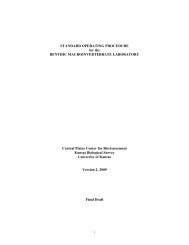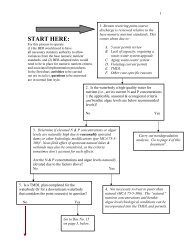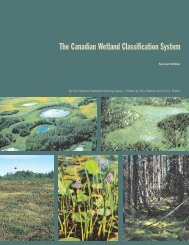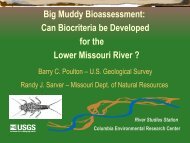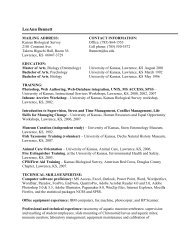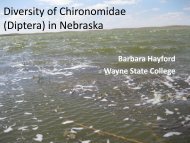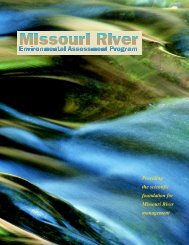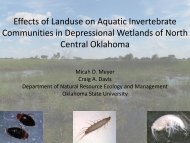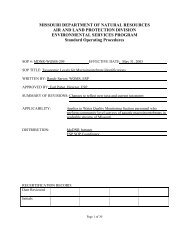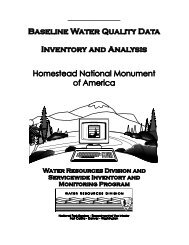Koontz, J., D.G. Huggins, C.C. Freeman, D.S. Baker - Central Plains ...
Koontz, J., D.G. Huggins, C.C. Freeman, D.S. Baker - Central Plains ...
Koontz, J., D.G. Huggins, C.C. Freeman, D.S. Baker - Central Plains ...
You also want an ePaper? Increase the reach of your titles
YUMPU automatically turns print PDFs into web optimized ePapers that Google loves.
CDF<br />
100<br />
90<br />
80<br />
70<br />
60<br />
50<br />
40<br />
30<br />
20<br />
10<br />
0<br />
0 1 2 3 4 5 6 7<br />
atrazine µg/L<br />
Figure 37. Cumulative distribution frequency (CDF) of atrazine of in reference (Phase I) and<br />
random (Phase II) populations.<br />
Resampled sites<br />
Four sites were resampled from Phase I (2005) and Phase II (2008); only three have all tiers of<br />
assessment data. Forney Lake, which lies in the Western Corn Belt <strong>Plains</strong>, was completely<br />
drained during summer 2005 when this area experienced drought conditions. Only disturbance<br />
assessments and FQA data were obtained there. The disturbance assessment score for 2005 and<br />
2008 were very similar, 12 and 13 respectively. FQI was 12.02 in 2005 and 16.26 in 2008.<br />
Richness values in 2005 (40 all plants, 32 native plants) were considerably higher than in 2008<br />
(18 for both). The dramatic difference in the scores is undoubtedly a consequence of the<br />
hydrological disturbance of drought and deluge, which promotes changes in plant community<br />
diversity. In 2005 there was only one hydrophyte species reported; there were six in 2008. The<br />
most dramatic shift in plant community structure was seen in the number of therophytes<br />
(annuals) present, which dropped from 20 in 2005 to one in 2008. Manipulation of wetland<br />
water level has been one of the most endearing best management practices for maintaining<br />
wetland floristic quality (Mitsch and Gooselink 2008).<br />
The other three sites are located in the <strong>Central</strong> Irregular <strong>Plains</strong> ecoregion and all three assessment<br />
tiers were accomplished during both survey phases. Swan Lake is a lacustrine, unconsolidated<br />
bed wetland type. There were noticeable differences in floristic and water quality as well as<br />
macroinvertebrate MMI scores. Though there are differences in the disturbance assessment<br />
scores, the difference is limited considering that scoring was reported by a different evaluator<br />
each year. In 2005 the disturbance assessment score was 12; in 2008 it was 14, with the most<br />
changes occurring in the hydrological attributes section – a section that be expected to change<br />
somewhat due to differing climatic conditions. Floristic quality assessments and<br />
macroinvertebrate metric indices indicated that this site had become more degraded in overall<br />
quality over the three-year period. Water chemistry measures show a trend in higher<br />
concentrations of nutrients and lower pesticide concentrations in the 2005 sampling season. It is<br />
52 of 84<br />
Phase One<br />
Phase Two



